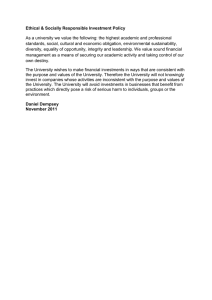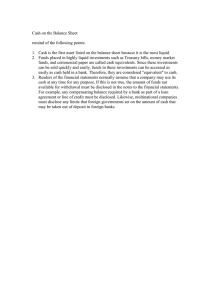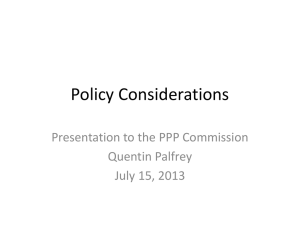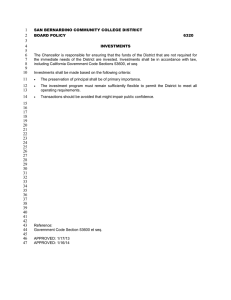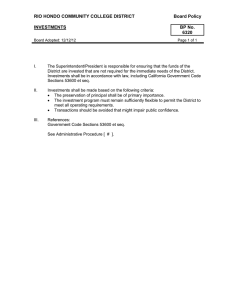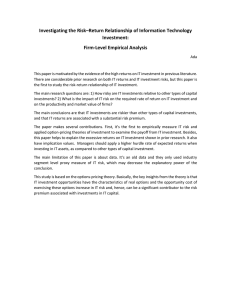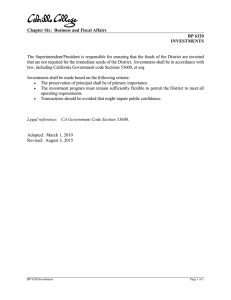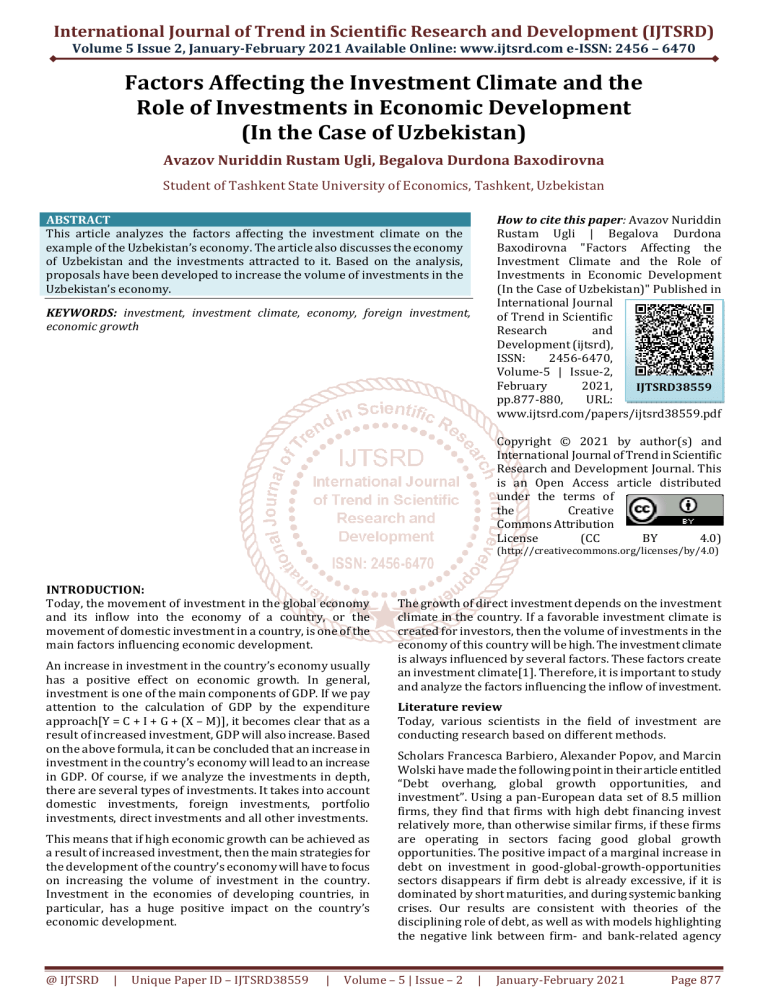
International Journal of Trend in Scientific Research and Development (IJTSRD)
Volume 5 Issue 2, January-February 2021 Available Online: www.ijtsrd.com e-ISSN: 2456 – 6470
Factors Affecting the Investment Climate and the
Role of Investments in Economic Development
(In the Case of Uzbekistan)
Avazov Nuriddin Rustam Ugli, Begalova Durdona Baxodirovna
Student of Tashkent State University of Economics, Tashkent, Uzbekistan
How to cite this paper: Avazov Nuriddin
Rustam Ugli | Begalova Durdona
Baxodirovna "Factors Affecting the
Investment Climate and the Role of
Investments in Economic Development
(In the Case of Uzbekistan)" Published in
International Journal
of Trend in Scientific
Research
and
Development (ijtsrd),
ISSN:
2456-6470,
Volume-5 | Issue-2,
February
2021,
IJTSRD38559
pp.877-880,
URL:
www.ijtsrd.com/papers/ijtsrd38559.pdf
ABSTRACT
This article analyzes the factors affecting the investment climate on the
example of the Uzbekistan’s economy. The article also discusses the economy
of Uzbekistan and the investments attracted to it. Based on the analysis,
proposals have been developed to increase the volume of investments in the
Uzbekistan’s economy.
KEYWORDS: investment, investment climate, economy, foreign investment,
economic growth
Copyright © 2021 by author(s) and
International Journal of Trend in Scientific
Research and Development Journal. This
is an Open Access article distributed
under the terms of
the
Creative
Commons Attribution
License
(CC
BY
4.0)
(http://creativecommons.org/licenses/by/4.0)
INTRODUCTION:
Today, the movement of investment in the global economy
and its inflow into the economy of a country, or the
movement of domestic investment in a country, is one of the
main factors influencing economic development.
An increase in investment in the country’s economy usually
has a positive effect on economic growth. In general,
investment is one of the main components of GDP. If we pay
attention to the calculation of GDP by the expenditure
approach[Y = C + I + G + (X – M)], it becomes clear that as a
result of increased investment, GDP will also increase. Based
on the above formula, it can be concluded that an increase in
investment in the country’s economy will lead to an increase
in GDP. Of course, if we analyze the investments in depth,
there are several types of investments. It takes into account
domestic investments, foreign investments, portfolio
investments, direct investments and all other investments.
This means that if high economic growth can be achieved as
a result of increased investment, then the main strategies for
the development of the country’s economy will have to focus
on increasing the volume of investment in the country.
Investment in the economies of developing countries, in
particular, has a huge positive impact on the country’s
economic development.
@ IJTSRD
|
Unique Paper ID – IJTSRD38559
|
The growth of direct investment depends on the investment
climate in the country. If a favorable investment climate is
created for investors, then the volume of investments in the
economy of this country will be high. The investment climate
is always influenced by several factors. These factors create
an investment climate[1]. Therefore, it is important to study
and analyze the factors influencing the inflow of investment.
Literature review
Today, various scientists in the field of investment are
conducting research based on different methods.
Scholars Francesca Barbiero, Alexander Popov, and Marcin
Wolski have made the following point in their article entitled
“Debt overhang, global growth opportunities, and
investment”. Using a pan-European data set of 8.5 million
firms, they find that firms with high debt financing invest
relatively more, than otherwise similar firms, if these firms
are operating in sectors facing good global growth
opportunities. The positive impact of a marginal increase in
debt on investment in good-global-growth-opportunities
sectors disappears if firm debt is already excessive, if it is
dominated by short maturities, and during systemic banking
crises. Our results are consistent with theories of the
disciplining role of debt, as well as with models highlighting
the negative link between firm- and bank-related agency
Volume – 5 | Issue – 2
|
January-February 2021
Page 877
International Journal of Trend in Scientific Research and Development (IJTSRD) @ www.ijtsrd.com eISSN: 2456-6470
prob- lems and corporate investment(Francesca Barbiero,
Alexander Popov, Marcin Wolski, 2020)[2].
Marcel Ausloos, Ali Eskandary, Parmjit Kaur, GurjeetDhesi
mentioned following statements in their article “Evidence for
Gross Domestic Product growth time delay dependence over
Foreign Direct investment. A time-lag dependent correlation
study”. They stateted that an often forgotten relationship the
time delay between a cause and its effect in economies and
finance. They treat the case of Foreign Direct Investment
(FDI) and economic growth, - measured through a country
Gross Domestic Product (GDP). The pertinent data refers to
43 countries, over 1970–2015, - for a total of 4278
observations. When countries are grouped according to the
Inequality-Adjusted Human Development Index (IHDI), it is
found that a time lag dependence effect exists in FDI–GDP
correlations. This is established through a time-dependent
Pearson’s product-moment correlation coefficient matrix.
Moreover, such a Pearson correlation coefficient is observed
to evolve from positive to negative values depending on the
IHDI, from low to high. It is ‘‘politically and policy relevant’’
that the correlation is statistically significant providing the
time lag is less than 3 years. A ‘‘rank-size’’ law is
demonstrated. It is recommended to reconsider such a time
lag effect when discussing previous analyses whence
conclusions on international business, and thereafter on
forecasting(Marcel Ausloos, Ali Eskandary, Parmjit Kaur,
Gurjeet Dhesi, 2019)[3].
Takeo Hoshia and Kozo Kiyotab mentioned following
information in their article titled “Potential for inward
foreign direct investment in Japan”. Promotion of inward
foreign direct investment (FDI) into Japan has been an
important policy in the Abenomicsgrowth strategy. If they
observe positive impacts of the policy in the data. They first
estimate agravity model of bilateral FDIs using data for 35
OECD countries as destination countries. In estimating the
model, They handle zero values for FDI stock explicitly. The
model includes (origin and destination) country specific
effects as well as destination-country specific time trends.
They take the model prediction as a reasonable
counterfactual and compare that to the actual inward FDI
stock for Japan. Although the actual inward FDI stock has
been growing and is likely to achieve the goal of 35 trillion
yen by 2020, the growth under the Abe administration has
been comparable to or slightly lower than the counterfactual
suggested by the estimated model. They also estimate the
model without Japan as a destination country and use the
estimated model to calculate the counterfactual level of
Japan’s inward FDI. Although they expect the gap between
the counterfactual and the actual become narrower if
Abenomics policy has been successful, we fail to find that.
These results cast a doubt on the effectiveness of the
Abenomics policies to encourage inward FDI at least as of
2015(Takeo Hoshia, Kozo Kiyotab , 2019)[4].
Data and methodology
Various conclusions have been drawn from this study based
on international research. In addition, the study examines
the economy of Uzbekistan by analytical methods. The study
also used induction, deduction and scientific abstraction
methods.
The increase in investment in the country’s economy
depends on the investment climate in the country. Therefore,
it is expedient to study the factors affecting the investment
climate in the country.
@ IJTSRD
|
Unique Paper ID – IJTSRD38559
|
Graph 1
Each of these factors includes several elements. These
factors are divided into components depending on their
nature. Each component, in turn, consists of several
influential factors.
Political factors include the following components:
Public investment, especially foreign investment policy;
The level of state intervention in the economy;
The degree of accession of the country to international
agreements;
Compliance of the country with international
agreements;
Stability of the political situation (political movements,
conflicts, peace in neighboring countries);
Targeted action of political power;
Effective functioning of the state apparatus;
Position of multi-party and political groups;
Tax, currency, price, monetary policy to investment
policy compatibility;
The environmental situation in the country and the
environmental situation of the government the scope of
health policy[5].
Social factors include the following components:
Indigenous people in relation to private property and
foreign investment
attitude;
Socio-economic situation of the country;
Ideological views of the population and their diversity;
Attitudes towards different nationalities in the country;
Literacy rate of the population;
Increased skills, competencies and experience of staff to
go and strive for it;
The attitude of the population to innovations and
various inventions and their acceptance degree of
making [6].
Economic factors include the following components:
Economic situation of the country;
Inflation rate;
Tax benefits;
Customs procedure;
Status of natural and raw material resources of the
country;
Status and value of labor;
The order of use of labor;
Demand and supply for certain goods;
Freedom of competition and price;
Currency conversion and national exchange rate
stability;
Bank interest rates;
Foreign economic relations of the country;
Geographical and territorial location of the country
(natural disasters, sea andland routes, climatic
conditions)[7].
Volume – 5 | Issue – 2
|
January-February 2021
Page 878
International Journal of Trend in Scientific Research and Development (IJTSRD) @ www.ijtsrd.com eISSN: 2456-6470
Legal factors include the following components:
The level of robustness of the legal framework for investment activities;
The legal framework that directly provides for investment activities degree of durability;
Normative bases of investment activity (decrees, decisions, laws, regulations, guidelines, etc. )[8].
Analysis аnd results
We analyze the growth of investment in the Uzbekistan’s economy and GDP growth.
Graph 1
Source: Compiled according to the State Committee on Statistics of the Republic of Uzbekistan.
URL: http://www.stat.uz
During the period under review, the economy grew by at least 5%. If in 2017 the economic growth was 5.3%, in 2018 it was
5.1% and in 2019 it was 5.6%.
Source: Compiled according to the State Committee on Statistics of the Republic of Uzbekistan.
URL: http://www.stat.uz
During the period under review, there has been a sharp increase in the dynamics of fixed capital investments. At the same time,
it can be seen that the growth rate increased from 7.1% in 2017 to 33.9% in 2019. This is definitely a positive sign in the
economy.
Based on the above data, it can be seen that investment has a positive impact on the economy of Uzbekistan. The data also show
that a favorable investment climate is developing in Uzbekistan. High economic growth can be achieved in the economy of
Uzbekistan on the basis of focusing economic policy on the formation of a favorable investment climate.
Conclusions
Investment has a positive effect on the economy. Investment
is especially important for GDP growth or economic growth.
Investments, in turn, have several components. There are
individual approaches to each of the components. The
increase or decrease of investments in the country depends
on the investment climate in the country. In general, the
investment environment can be considered as a set of
opportunities created for the movement of investments.
@ IJTSRD
|
Unique Paper ID – IJTSRD38559
|
As mentioned above, the investment climate is influenced by
political, economic, social and legal factors. When each factor
is studied separately, certain components are also
distinguished from them. These factors create a favorable
investment climate. The basis of the country’s economic
policy is to ensure the positive impact of these factors on the
investment climate. If the country can do that, investment in
the economy will increase.
Volume – 5 | Issue – 2
|
January-February 2021
Page 879
International Journal of Trend in Scientific Research and Development (IJTSRD) @ www.ijtsrd.com eISSN: 2456-6470
If we pay attention to the economy of Uzbekistan, the
country has been achieving high economic growth in recent
years. There are, of course, a number of factors that
contribute to this achievement. Investment also has a
positive effect on this indicator. In addition, the volume of
investment in the country’s economy has grown
significantly. Therefore, the economy of Uzbekistan can be
considered as one of the main tools for economic growth of
investments and increase the volume of investments in the
country’s economy on the basis of creating a favorable
investment climate.
Literatures
[1] Avazov, N., &Turakulov, Z. (2020). DEVELOPMENT OF
THE ECONOMY BASED ON ACTIVE ATTRACTION OF
FOREIGN
INVESTMENTS.
Архив
научных
исследований, 1(23).
извлечено
от
https://journal.tsue.uz/index.php/archive/article/vie
w/2733
[2]
Francesca Barbiero, Alexander Popov, Marcin Wolski.
(2020). Debt overhang, global growth opportunities,
and investment. Journal of Banking and Finance, 1-16.
https://www.sciencedirect.com/science/article/abs/
pii/S0378426620302120
[3]
Marcel Ausloos, Ali Eskandary, Parmjit Kaur, Gurjeet
Dhesi. (2019). Evidence for Gross Domestic Product
growth time delay dependence over Foreign Direct
investment. A time-lag dependent correlation study.
Physica
A,
527-538.
https://www.sciencedirect.com/science/article/abs/
pii/S0378437119307125
[4]
The Japanese and International Economies, 32-52.
https://www.sciencedirect.com/science/article/pii/S
0889158318301370
[5]
Makhmudov N. M., Avazov N. R., “THE DIGITAL
ECONOMY: A NEW STAGE IN THE DEVELOPMENT OF
THE WORLD ECONOMY”. СТУДЕНТ ГОДА
2020сборник статей Международного учебноисследовательского конкурса. Петрозаводск, 2020
https://www.elibrary.ru/item.asp?id=44586361&pf=
1
[6]
Avazov N. R., “INTERNATIONAL TRADE THEORIES
AND THE IMPACT OF INTERNATIONAL TRADE ON
FOREIGN INVESTMENT”. ЭКОНОМИСТ ГОДА
2020сборник
статей
Международного
профессионально-исследовательского конкурса.
Петрозаводск,
2020.
https://www.elibrary.ru/item.asp?id=44586595&pf=
1
[7]
AvazovN. R., “Критерии и направления
обеспечения экономической безопасности (на
основе международного опыта)”. СТУДЕНТ ГОДА
2020Сборник статей XVI Международного научноисследовательского
конкурса.
2020.,
https://www.elibrary.ru/item.asp?id=44454405&pf=
1
[8]
Avazov, N., &Maxmudov, N. (2020). INVESTMENT AS
A SOURCE OF FINANCING. Архив научных
исследований, 1(24).
извлечено
от
https://journal.tsue.uz/index.php/archive/article/vie
w/2803
Takeo Hoshia, Kozo Kiyotab . (2019). Potential for
inward foreign direct investment in Japan. Journal of
@ IJTSRD
|
Unique Paper ID – IJTSRD38559
|
Volume – 5 | Issue – 2
|
January-February 2021
Page 880


